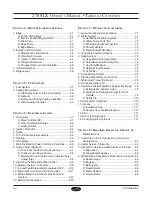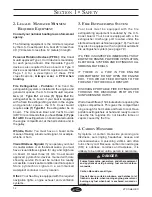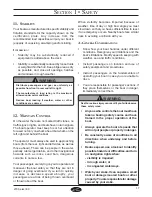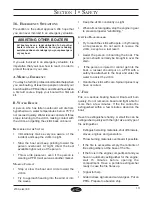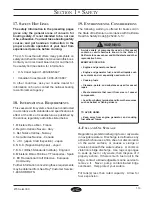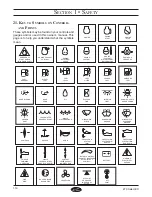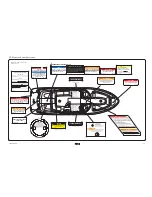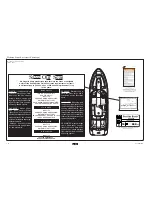
1.9
S
ECTION
1 • S
AFETY
270 Select EX
Skiers must wear an approved PFD.
!
WARNING
Shut engine off if an object is struck or if you run
aground.
Check for hull leaks and drive line damage, before
restarting engines.
Use hand pump if bilge pumps don’t remove water.
Boat very slowly, if you must proceed with a damaged
drive line.
!
WARNING
Hitting an object in or under the water or boating in
dangerous currents can cause serious injury or death
to boat occupants.
You must know where the hazards are and avoid them.
In uncharted waters, boat very slowly and post a
lookout.
!
WARNING
15. W
ATER
S
PORTS
A. S
WIMMING
•
Do not permit anyone to swim from a moving
boat, or a boat with an engine running.
•
Many localities prohibit swimming from boats
except in designated areas.
•
Make sure boat’s engines are turned off before
allowing people to swim anywhere near your
boat. Shut the engine OFF and remove the key
from the ignition switch so that no one can
accidentally start the engine while swimmers
are nearby.
•
Turn off engines when taking swimmers or
skiers aboard or when they are entering the
water. Never permit use of the transom or swim
platform while engines are running.
•
Slow down and look for swimmers or skiers
when cruising in an area where there might be
persons in the water.
B. S
KIING
It is advised that you become familiar with water
skiing safety and hand signals as you will most
likely, on occasion, find yourself in the vicinity of or
engaging in water skiing activity.
•
Anyone who water skis must know how to swim.
Your boat can kill or injure persons in the water.
Always stay away from areas designated for
swimming or diving. Unless you are towing a skier,
stay away from water ski areas. Recognize markers
used for such areas.
When engine is running, close and lock transom door
and do not permit anyone to use boarding ladder and
swim platform.
!
WARNING
14. C
HART
Y
OUR
C
OURSE
To avoid boating in unsafe areas where there are
underwater obstructions, shallow water,
unnavigable conditions such as dangerous
currents, and others, you must chart a course. This
means having and using the National Oceanic and
Atmospheric Administration (NOAA) charts for
coastal waters, observing and understanding all
navigational aids, using the knowledge and
guidance of experienced boaters, and being aware
of the tide times where appropriate.
If you are in an unfamiliar area without knowledge
of the hazards, proceed very slowly and have
someone watch for hazards.
Let others know where you are going.
A float
plan describes your intended cruising course and
itinerary, boat description, and your expected time
and date of return. Give the float plan to a friend or
relative, so they can give the information to a
national boat agency, like the U.S. Coast Guard, in
the event you fail to return.
Summary of Contents for 270 Select EX
Page 1: ...Owner s Manual Part Number MRP 1803645 Sea Ray Owner s Manual 270 Select EX...
Page 2: ......
Page 4: ...270 Select EX ii THIS PAGE LEFT INTENTIONALLY BLANK...
Page 46: ...2 16 SECTION 2 GENERAL BOAT ARRANGEMENT 270 Select EX THIS PAGE LEFT INTENTIONALLY BLANK...
Page 66: ...5 4 SECTION 5 FUEL SYSTEM 270 Select EX THIS PAGE LEFT INTENTIONALLY BLANK...
Page 102: ...7 12 SECTION 7 OPTIONS ACCESSORIES 270 Select EX THIS PAGE LEFT INTENTIONALLY BLANK...
Page 106: ...270 Select EX Index 4 INDEX THIS PAGE LEFT INTENTIONALLY BLANK...




